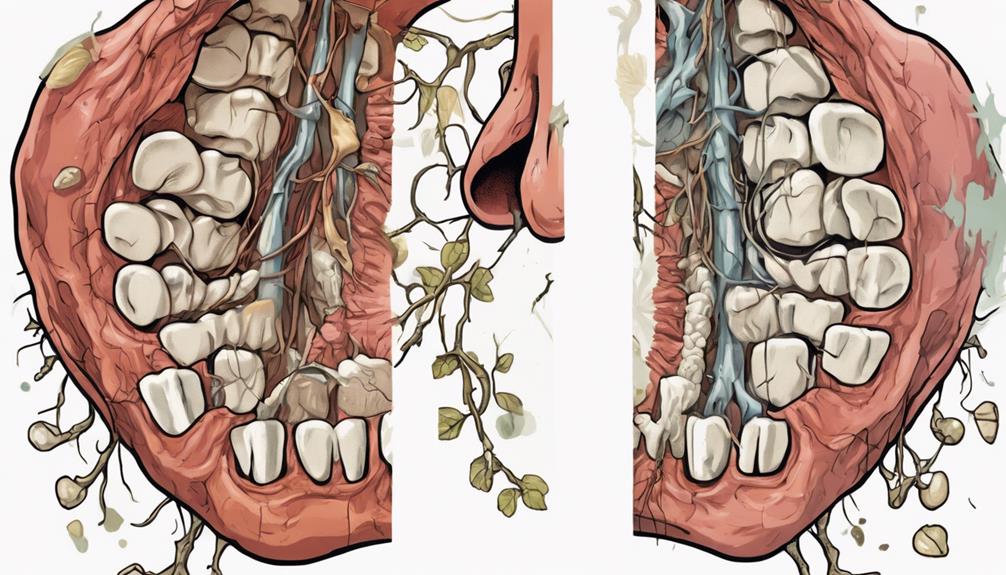Teething usually starts around six months, and your baby's first tooth is likely the lower central incisor, coming in between six to ten months. Next, expect the upper central incisors to appear between eight and twelve months. The process continues with lateral incisors, first molars, and second molars coming in over the next couple of years. You might notice signs like drooling, swollen gums, and fussiness during this time. Providing safe objects for chewing can help soothe your little one's discomfort. There's so much more to understand about teeth and oral care during this exciting stage of development.
Key Takeaways
- Teething usually starts around 6 months of age, but can begin anywhere from 3 to 12 months.
- The first teeth to erupt are typically the lower central incisors, appearing between 6-10 months.
- Upper central incisors follow, emerging between 8-12 months, with lateral incisors coming in next (9-13 months).
- First molars usually erupt between 13-19 months, while second molars are the last, appearing between 25-33 months.
Teething Timeline Overview

Teething usually kicks off around 6 months, but some babies might start as early as 3 months or as late as 12 months. Generally, the first tooth erupts at around 6 to 10 months, with the lower central incisors being the first to come in. Following these, the upper central incisors usually appear between 8 to 12 months. By the time your little one reaches age 3, all 20 primary teeth should be in place.
During this time, you may notice various teething symptoms. Some babies experience mild signs of discomfort, while others face significant teething pain. Keeping a tooth eruption chart handy can help you track the process and identify when to expect each tooth. Teething rings can be a lifesaver, providing relief as your teething baby gnaws away.
It's essential to remember that baby teeth fall out at around 6 years of age, making way for permanent teeth. Individual timelines can vary widely, so don't be alarmed if your child's experience doesn't match the typical pattern. Understanding this timeline can help you manage your baby's teething journey with greater ease.
Signs of Teething
When your baby starts teething, you might notice some common signs that indicate discomfort.
Increased drooling, irritability, and a strong urge to chew on objects are all typical symptoms.
Understanding these signs can help you manage your baby's teething discomfort more effectively.
Common Teething Symptoms
As your baby enters the teething phase, you might notice signs like increased drooling, swollen gums, and a strong urge to chew on anything nearby. These teething symptoms often begin around 3-6 months of age, and they can lead to noticeable fussiness and irritability. Your little one may also experience appetite changes, showing less interest in feeding or refusing certain foods.
Sleeping patterns might be disrupted too; your baby may have difficulty settling down due to teething discomfort. In some cases, you might even observe a low-grade fever—typically less than 102°F—during this time. It's a natural response as those tiny teeth push through the gums.
You may find your baby biting on fingers, toys, or even household items as a way to alleviate gum pain. While swollen gums and increased drooling are common, it's crucial to remember that a high fever or diarrhea usually signals other health issues unrelated to teething.
Keeping an eye on these teething symptoms can help you better understand what your baby is going through during this significant developmental stage.
Managing Teething Discomfort
Recognizing the signs of teething can help you find effective ways to manage your baby's discomfort during this challenging phase. Common signs of teething include increased drooling, a desire to chew on objects, and swollen and tender gums. You may also notice irritability and fussiness, which can disrupt your baby's sleep patterns.
To soothe your little one, try giving them chilled teething rings or a clean, damp washcloth to chew on. These can provide relief for their sore gums. Some parents find that teething gels can help ease discomfort, but it's important to consult your healthcare provider before using any products.
As you watch your baby, pay attention to their appetite; decreased interest in food can be a sign of teething discomfort. If your baby exhibits severe irritability or a high fever (over 100.4°F), it's vital to contact your healthcare provider to rule out other health issues.
Managing teething discomfort is all about recognizing these signs early and taking action to help your baby feel more comfortable as their teeth begin to emerge.
Order of Tooth Eruption

The order of tooth eruption in babies begins with the lower central incisors, typically emerging between 6-10 months of age. These are the first teeth to come in and mark the start of your baby's dental journey.
Next, around 8-12 months, the upper central incisors appear, adding to your baby's growing smile. Following those, the lateral incisors erupt between 9-13 months, helping your little one chew more effectively.
Soon after, the first molars come in, usually between 13-19 months, providing additional support for chewing. As your baby approaches 16-22 months, you'll likely see the canines emerge, completing the front teeth.
The second molars are the last to make their appearance, generally erupting between 25-33 months. By the time your child is about 3 years old, they'll typically have a complete set of 20 primary teeth.
These primary teeth play a vital role in chewing and speech development, setting the foundation for their adult teeth later on. Understanding this order of tooth eruption can help you anticipate and celebrate each milestone in your baby's dental development.
Soothing Teething Discomfort

Teething can be a challenging time for both you and your baby, but several effective methods can help soothe their discomfort.
Gently rubbing your baby's gums with a clean finger can provide immediate relief from the pressure and soreness caused by swollen gums. Chilled teething rings or frozen washcloths are great options for cooling down their gums. Just make sure to avoid liquid-filled teething rings that might break.
If you're considering teething biscuits, keep a close eye on your baby to monitor for any choking hazards, as some biscuits can break off easily. A slight increase in temperature can occur during teething, but if your baby develops a true fever (over 100.4°F), it's wise to consult your pediatrician to rule out any illness.
For additional relief, over-the-counter pain relief medications like acetaminophen or ibuprofen can be used, but only under the guidance of a healthcare provider. Be cautious with teething gels; avoid those containing benzocaine for infants under 2 years old.
With these tips, you can help ease your baby's teething discomfort, making this phase a bit more manageable for both of you.
Oral Hygiene for Infants

Establishing good oral hygiene for your infant starts even before their first tooth appears. You should begin cleaning your baby's gums with a soft cloth to help establish healthy habits early on.
Once your baby's first teeth come in, switch to a soft-bristled toothbrush. Use only a smear of fluoride toothpaste—about the size of a grain of rice—to brush your child's teeth twice daily, ideally after breakfast and before bed. This routine prevents tooth decay and supports healthy oral development.
As your baby's teeth begin to touch, it's time to introduce flossing. Flossing helps remove plaque buildup between teeth, promoting overall dental health.
Don't forget to schedule your child's first dental visit by age 1 or within six months of their first tooth eruption. This guarantees proper monitoring of their oral hygiene and helps address any concerns early on.
Pediatrician Recommendations

Pediatricians suggest scheduling your child's first dental visit by age 1 or soon after their first tooth appears to guarantee proper monitoring of their oral health. This early visit helps establish a dental home and ensures your child's dental health is on track.
Here are some key recommendations from pediatricians:
- Fluoride varnish: This treatment can be applied during well-child visits to strengthen tooth enamel and help prevent decay.
- Daily oral hygiene routine: Start early with gentle gum cleaning and tooth brushing to promote long-term dental health.
- Consult on fluoride needs: Discuss your child's fluoride requirements with your pediatrician to provide optimal protection for their teeth.
- Avoid certain teething gels: Pediatricians advise against using teething gels containing benzocaine for infants under 2 due to safety concerns.
First Dental Visit

Scheduling your child's first dental visit around their first birthday is essential for ensuring their oral health starts off on the right foot. This visit should happen after their first tooth erupts or by their first birthday, whichever comes first. Establishing a 'dental home' at this age helps support ongoing dental health and continuity of care.
During the first dental visit, a pediatric dentist will check for any dental issues and assess your child's dental development. They'll provide guidance on oral hygiene practices tailored for young children, helping you understand how to care for those tiny teeth. You'll also learn about teething and preventive care strategies to keep dental problems at bay.
Don't hesitate to ask questions during this visit. It's a great opportunity to discuss your child's dental health and establish a routine for regular dental check-ups.
Frequently Asked Questions
How Do Baby Teeth Come in Order?
Baby teeth come in a specific order: first, the lower central incisors, then the upper central incisors, followed by lateral incisors, molars, canines, and finally, the second molars, finishing by age three.
How Do Babies Teeth Start Coming In?
When babies start teething, you might notice drooling and chewing on objects. Their gums can feel sore, and they may become fussy. It's a natural process, and each child's timeline can vary considerably.
How Long Do Babies Take to Get Teeth?
Babies usually take about two to three years to get all their teeth. You can expect their first teeth to appear around six months, with a total of 20 primary teeth emerging by age three.
How Do Babies Teeth Break Through?
When babies' teeth break through, they push against the gums, causing pressure and discomfort. You might notice swelling or redness, and your little one may drool more or want to chew on objects for relief.
What is the Normal Timeline for Baby Teeth to Come In?
Babies typically begin to get teeth around 6-10 months of age. The first ones to come in are usually the bottom front teeth, followed by the top front teeth. By age 3, most children have a full set of baby teeth. It’s important to know how babies get teeth to monitor their oral health. Teething in babies can be a challenging time for both the child and their parents. It can cause discomfort, irritability, and disrupted sleep. To help alleviate teething pain, parents can give their baby teething toys, gently massage their gums, or give them a cold washcloth to chew on. It’s important to monitor their oral health during this time and visit a pediatric dentist if there are any concerns.
Conclusion
In summary, steering through your baby's teething journey can feel like sailing through a storm—challenging yet manageable.
By understanding the timeline, recognizing signs, and soothing their discomfort, you can help ease this change.
Remember to maintain good oral hygiene and consult your pediatrician for guidance.
Scheduling that first dental visit is essential too.
With your support, your little one will come through this phase with a bright smile, ready to explore the world around them.









